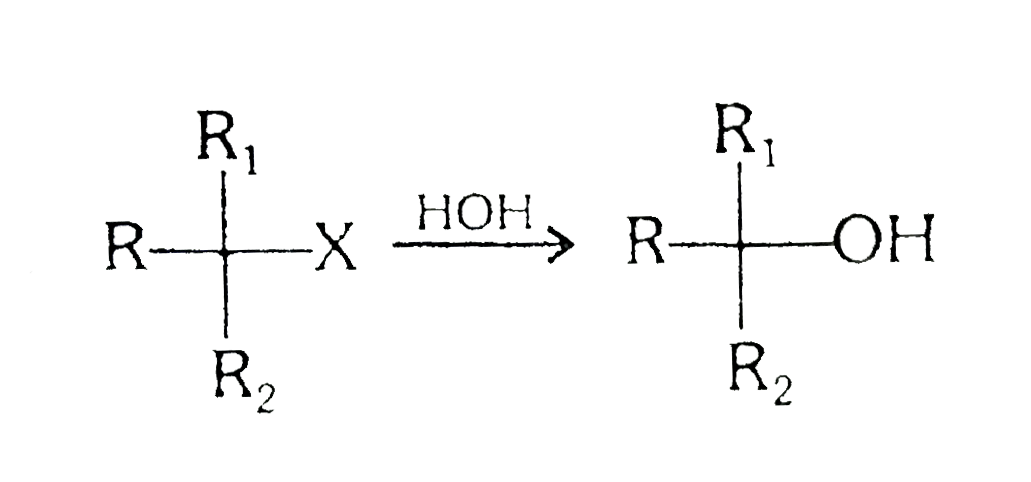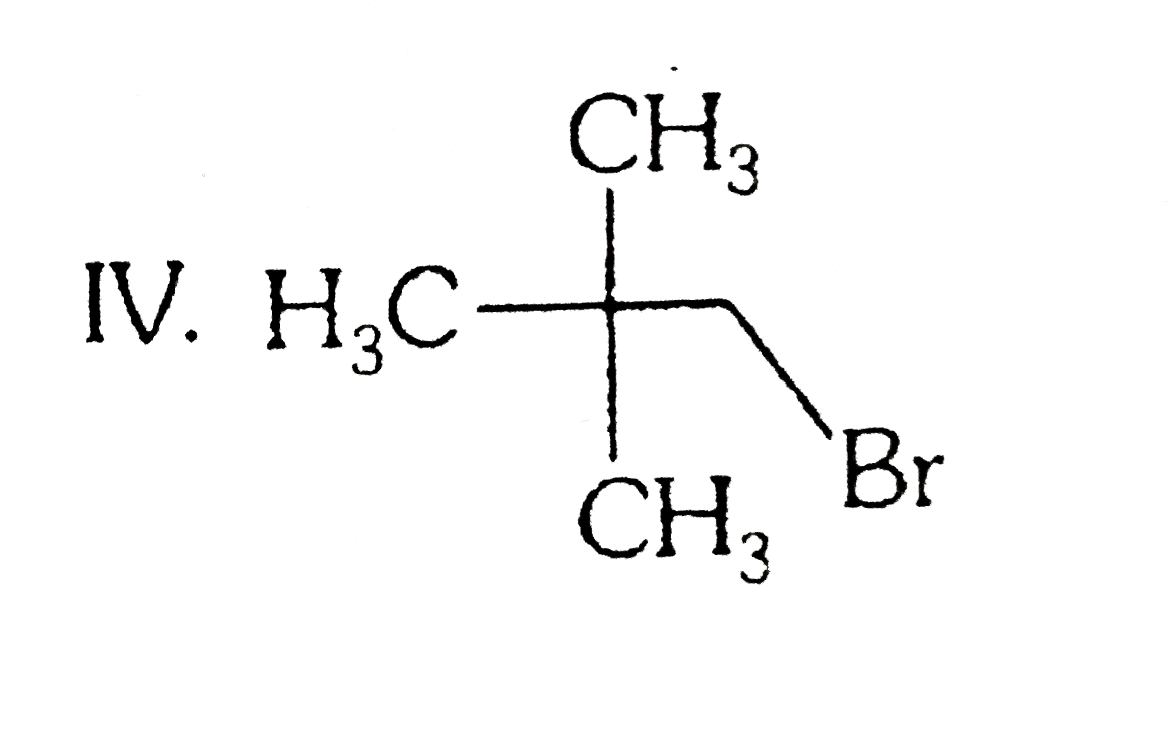In SN1 reaction an optically active substrates mainly gives
Retention in configuration
Inversion in configuration
Racemic product
No products
The correct Answer is:C
To solve the question regarding the outcome of an SN1 reaction involving optically active substrates, we can break down the steps as follows:
1. Understanding SN1 Reaction:
- The SN1 (Substitution Nucleophilic Unimolecular) reaction involves two main steps: the formation of a carbocation intermediate and the nucleophilic attack.
- The rate-determining step is the formation of the carbocation, which is influenced by the stability of the carbocation.
2. Formation of Carbocation:
- When an optically active substrate undergoes an SN1 reaction, it first loses its leaving group (e.g., a halide ion), resulting in the formation of a planar carbocation.
- This carbocation is sp² hybridized and can be attacked by the nucleophile from either side, leading to different configurations.
3. Nucleophilic Attack:
- Since the carbocation is planar, the nucleophile can attack from either the front (retaining the original configuration) or the back (inverting the configuration).
- This results in two possible outcomes: retention of configuration (same as the original) and inversion of configuration (opposite to the original).
4. Probability of Each Outcome:
- The nucleophile has an equal probability (50%) of attacking from either side of the planar carbocation.
- Therefore, there is a 50% chance of obtaining the original configuration (retention) and a 50% chance of obtaining the inverted configuration.
5. Resulting Product:
- The combination of both outcomes leads to a racemic mixture, which contains equal amounts of both enantiomers (the retained and inverted forms).
- Thus, the product formed from an optically active substrate in an SN1 reaction is a racemic mixture.
Conclusion:
The correct answer to the question is that in an SN1 reaction involving optically active substrates, the product formed is a racemic product.
---
- The SN1 (Substitution Nucleophilic Unimolecular) reaction involves two main steps: the formation of a carbocation intermediate and the nucleophilic attack.
- The rate-determining step is the formation of the carbocation, which is influenced by the stability of the carbocation.
- When an optically active substrate undergoes an SN1 reaction, it first loses its leaving group (e.g., a halide ion), resulting in the formation of a planar carbocation.
- This carbocation is sp² hybridized and can be attacked by the nucleophile from either side, leading to different configurations.
- Since the carbocation is planar, the nucleophile can attack from either the front (retaining the original configuration) or the back (inverting the configuration).
- This results in two possible outcomes: retention of configuration (same as the original) and inversion of configuration (opposite to the original).
- The nucleophile has an equal probability (50%) of attacking from either side of the planar carbocation.
- Therefore, there is a 50% chance of obtaining the original configuration (retention) and a 50% chance of obtaining the inverted configuration.
- The combination of both outcomes leads to a racemic mixture, which contains equal amounts of both enantiomers (the retained and inverted forms).
- Thus, the product formed from an optically active substrate in an SN1 reaction is a racemic mixture.
The correct answer to the question is that in an SN1 reaction involving optically active substrates, the product formed is a racemic product.
Topper's Solved these Questions
- ALKYL AND ARYL HALIDEBOOK - ALLENCHAPTER - ALKYL AND ARYL HALIDEEXERCISE - EXERCISE-02
1 Videos
- ALKYL AND ARYL HALIDEBOOK - ALLENCHAPTER - ALKYL AND ARYL HALIDEEXERCISE - EXERCISE-04 [A]
1 Videos
- ALKYL AND ARYL HALIDEBOOK - ALLENCHAPTER - ALKYL AND ARYL HALIDEEXERCISE - EXERCISE-01
1 Videos
- ALKENE, ALKANE & ALKYNE BOOK - ALLENCHAPTER - ALKENE, ALKANE & ALKYNE EXERCISE - EXCERSISE-3
28 Videos
- Atomic StructureBOOK - ALLENCHAPTER - Atomic StructureEXERCISE - All Questions
62 Videos
Similar Questions
Knowledge Check
An optically active compound
Arotates the plane of polarised lightBchanges the direction of polarised lightCdoes not allow plane polarised light to pass throughDnone of these.SN1 reaction is fastest in
ACH3CH2BrBCH3−CH∣Cl−CH3CCH3−CH3C∣∣CH3−ClDCH3−CH∣CH2∣CH3−Cl
What is optical activity ?
View SolutionNucleophilic aliphatic substitution reaction is mainly of two types: SN1 and SN2. The SN1 mechanism is a two step process. Reaction velocity of SN1 reaction depends only on the concentration of the substrate. Since product formation takes place by the formation of carbocation, optically active substrate gives (+) and (-) forms of the product. In most of the cases the product usually consits of 5−20% inverted product and 80−95% racemised species. The more stable the carbocation, the greater is the proportion of racemisation. In solvolysis reaction, the more nucleophilic the solvent, the greater is the proportion of inversion.
For the gives reaction,
Which substrate will give maximum racemisation?
View SolutionNucleophilic aliphatic substitution reaction is mainly of two types: SN1 and SN2. The SN1 mechanism is a two step process. Reaction velocity of SN1 reaction depends only on the concentration of the substrate. Since product formation takes place by the formation of carbocation, optically active substrate gives (+) and (-) forms of the product. In most of the cases the product usually consits of 5−20% inverted product and 80−95% racemised species. The more stable the carbocation, the greater is the proportion of racemisation. In solvolysis reaction, the more nucleophilic the solvent, the greater is the proportion of inversion.
Which one of the following compound will give SN1 reaction predominantly?
View SolutionAssertion : SN2 reaction of an optically active aryl halide with an aqueous solution of KOH always gives an alcohol with opposite sign of rotation.
Reason : SN reactions always proceed with inversion of configuration.
View SolutionNucleophilic aliphatic substitution reaction is mainly of two types: SN1 and SN2. The SN1 mechanism is a two step process. Reaction velocity of SN1 reaction depends only on the concentration of the substrate. Since product formation takes place by the formation of carbocation, optically active substrate gives (+) and (-) forms of the product. In most of the cases the product usually consits of 5−20% inverted product and 80−95% racemised species. The more stable the carbocation, the greater is the proportion of racemisation. In solvolysis reaction, the more nucleophilic the solvent, the greater is the proportion of inversion.
Which of the following compounds will give SN1 and SN2 reactions with considerable rate?
I. C6H5−CH2−Br (II) CH2=CH−CH2−Br (III) CH3−CH(Br)CH3 (IV)
Select the correct answer from teh codes given below
View SolutionSN reaction is given by these compounds, which have a nuclophilic group and a good leaving EWG. It should be stable after leaving with bonding pair of ¯e's and it should have high polarisability.
Nucliphilic aliphatic substituion reaction is mainly of two types SN−1 and SN2.SN−1 mechanism is a two step process. Reaction velocity of SN−1 depends only on the concentration of the subtrate. It proceeds via the formation of carbocation, optically active substrate gives (⊕) and (o−) froms of the product.
In most of the cases, the product usually consists of 5−20% inverted and (95−80%) racemised species. The more stable is the carbocation, the greater is the propotion of racemisation. In solvolysis reaction, the more nucleophillic is the solvent, the greater is the proportion of inversion.
For the reaction

which substrate will give maximum racemismision ?
View Solution
